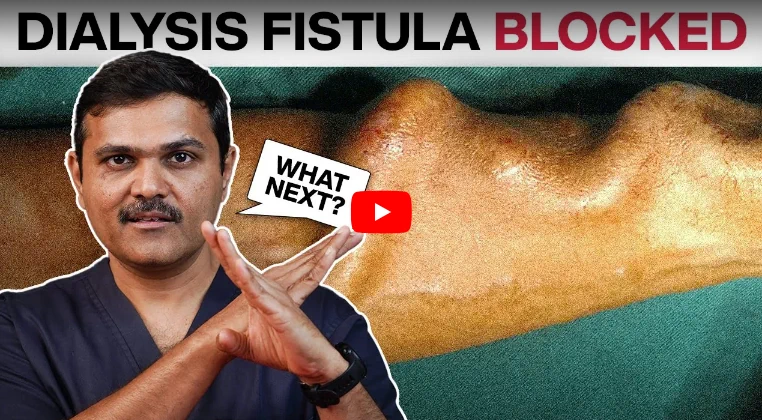
Dialysis might sound scary, and indeed, it’s a serious commitment that can turn your world upside down. In India alone, over 175,000 people require dialysis, and this number is rising annually.
If you or a loved one are facing this reality, it’s crucial to understand the various types of dialysis catheters, as the right choice can significantly impact your quality of life.
This blog will demystify the different types of dialysis catheters, highlight the pros and cons of each, and guide you to the best care available. Ready to dive in? Let’s get started.
Types of Dialysis Catheter
Dialysis catheters are essential tools that provide access to your blood for the dialysis process.
There are several types, each suited to different needs and circumstances. Here, we’ll explore four main types: Central Venous Catheters (CVCs), Arteriovenous (AV) Fistulas, AV Grafts, and Peritoneal Dialysis Catheters.
1. Central Venous Catheter (CVC)
A Central Venous Catheter, often referred to as a CVC, is a tube inserted into a large vein, typically in the neck, chest, or groin. It’s usually used for temporary or emergency dialysis access.
Pros:
- Quick to place and ready for immediate use.
- Useful in urgent situations where other access types are not viable.
Cons:
- Higher risk of infections and clotting compared to other access types.
- Not suitable for long-term use.
In India, about 30% of dialysis patients start with a CVC due to the urgent need for treatment and the lack of early referral to nephrologists.
2. Arteriovenous (AV) Fistula
An AV fistula is created by surgically connecting an artery directly to a vein, usually in the arm. This connection causes the vein to grow stronger and larger, making repeated needle insertions easier.
Pros:
- Lower risk of infections and clotting.
- Long-lasting and considered the gold standard for dialysis access.
Cons:
- Takes several weeks to months to mature and be ready for use.
- Not all patients have suitable veins for creating a fistula.
In India, AV fistulas are used by around 40% of patients, but the percentage should ideally be higher for better long-term outcomes.
Also Read: AV Fistula Complications
3. Basilic Vein Transposition
In this advanced surgery technique, the basilic vein in arm ( from elbow to axilla) is harvested and transposed superficially and connected to the brachial artery.
Pros:
- Suitable for people with blocked AV fistula/ unsuitable veins
- Good alternative to AV graft
Cons:
-
-
- Longer surgery
- Takes 2 months to develop
- Can develop narrowing at axilla level
-
4. Peritoneal Dialysis Catheter
A Peritoneal Dialysis Catheter is used for peritoneal dialysis, a process that uses the lining of your abdomen to filter your blood inside your body. The catheter is placed in your abdomen through a minor surgical procedure.
Pros:
- Allows for home-based dialysis, offering greater flexibility and convenience.
- Lower risk of blood infections compared to CVCs.
Cons:
- Requires daily management and a clean environment to avoid infections.
- Not suitable for all patients, especially those with abdominal surgeries or hernias.
In India, about 10% of dialysis patients opt for peritoneal dialysis, with the number gradually increasing due to its convenience and flexibility.

Vein Specialist Doctor Near Me
Finding a qualified and experienced vein specialist is crucial for ensuring the best possible outcomes for dialysis access procedures. Dr. Sumit Kapadia, a renowned vascular surgeon in Vadodara, offers expert care in this field.
With extensive experience in creating and managing all types of dialysis accesses, Dr. Kapadia ensures that patients receive the highest quality of care tailored to their specific needs.
Conclusion
Choosing the right type of dialysis catheter is a critical decision that significantly impacts your health and quality of life. Understanding the options available, from CVCs to AV fistulas, AV grafts, and peritoneal dialysis catheters, can help you make an informed choice.
Dr. Sumit Kapadia, the best vascular surgeon in Vadodara, and his team at Aadicura are dedicated to providing top-notch care and personalized treatment plans for dialysis patients. With the right specialist by your side, you can navigate the complexities of dialysis with confidence and peace of mind.
For more information or to schedule a consultation with Dr. Sumit Kapadia, visit Aadicura, the leading vascular care center in Vadodara, and take the first step towards better health today.
FAQs
The most common type of dialysis access in India is the AV fistula, used by approximately 40% of patients due to its lower risk of infections and long-term durability.
An AV fistula typically takes several weeks to months to mature and be ready for use, depending on the individual patient’s vascular health and the success of the surgery.
No, a CVC is generally not recommended for long-term use due to its higher risk of infections and complications. It’s primarily used for temporary or emergency access.
AV grafts carry a higher risk of infections and clotting compared to AV fistulas. They may also require more frequent medical interventions to keep them functioning properly.
No, peritoneal dialysis is not suitable for everyone. Patients with certain abdominal conditions or previous abdominal surgeries may not be candidates for this type of dialysis.

MBBS, MS, MRCS, DNB-Fellow
Dr. Sumit Kapadia
Dr. Sumit Kapadia / MR KAPADIA SUMIT a gold-medalist from Baroda Medical College, obtained his general surgical training and senior residency from SSG Hospital, Vadodara.

MBBS, MS, MRCS, DNB-Fellow
Dr. Sumit Kapadia
Dr. Sumit Kapadia / MR KAPADIA SUMIT a gold-medalist from Baroda Medical College, obtained his general surgical training and senior residency from SSG Hospital, Vadodara.



